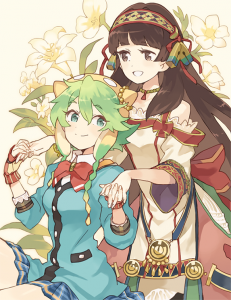
Since the start of the Dusk/Twilight trilogy, Gust has experimented with gameplay elements while having a somewhat darker story with the Earth in decline. In the last game, Escha and Logy allowed all 6 members (three active) to participate in battle while improving the alchemy gameplay by allowing you to choose the traits again. Also, you can see what tasks you need to get done along with what rewards you will get if you get a line up. Of course, the biggest addition is that there are now two protagonists you can play as, which has not been in the game since Mana Khemia 2.
The third and possibly last entry in the Dusk/Twilight trilogy is Atelier Shallie, which of course not only have dual protagonists (both female), but it also bring backs some game mechanics from Mana Khemia 2 such as getting rid of the time limit, variable strike and the burst gauge while introducing some new features and improvements. Since I have beaten the game at least once, its time to share my thoughts.
The story is centered on an oasis city of Stellard, which is on the edge of the Dusk Sea. Sollie is assigned by Central to investigate the reason why the town’s water supply is being depleted. The overall story will depend on what protagonist the player chooses: Shallistera and Shallotte. Shallistera is a princess of a clan that came from a faraway village called Lugion. She came to Stellard to receive help on why her village’s water supply is drying up. On the other hand, Shallotte Elimus is a cheerful girl who lives in Stellard doing mundane tasks of sweeping streets. She dreams of accomplishing something big and of course learn how to fly. Eventually, both of their stories will converge as they decide to work together.
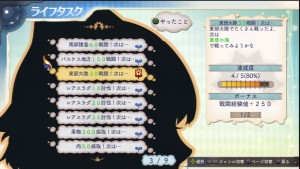
Unlike the last two games, the time limit is gone. This means that you don’t have to worry about running out of time or manage time. This is made possible with the new Life Task system. It will generate tasks depending on your play style in the four categories: Heart, Skill, Body and People (心・技・体・人). For instance, if you spend time making items, you will get tasks relating to making certain items. If you spend most of your time fighting monsters, you will receive tasks to defeat certain stronger monsters. After finishing a task, you will get a reward and a boost to the motivation meter. The more life tasks you do, the higher the life task and motivation meter will go. Once filled, you can advance to the next chapter.

Although this system allows the player to play the game at his or her pace, of course some people might not like it since it’s not possible to sleep and then go to the next chapter. However, the lack of a time limit benefits the endgame. While the motivation meter slowly decreases if you don’t do any life tasks, it doesn’t seem to matter once you reach the final chapters since it will never decrease and will stay filled. This means that you can spend your time making the best items, ultimate weapons and of course, beating optional bosses at the highest difficulty. Once you beat the game, equipped items, equipment and money will be carried over to the second play through.

As for the Alchemy system, it has been simplified a bit further along with ingredients having random traits making a return (as indicated with a special background). Instead of picking the order and deciding what skills to use, you just place the skills on one of the slots for each ingredient and rearrange the order of the ingredients as you please. Each ingredient has a number of slots where you can place the skills on. Some skills might use two or three of these slots. When your alchemy level increases, skills will either become powerful or use fewer slots.
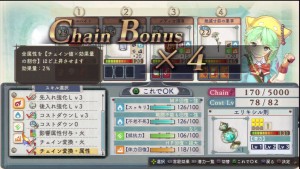
New to the alchemy system is chaining. When you use the same skill in the same element more than two times, you might get a chain bonus. A chain bonus will increase the skill’s effect. Each element has a chain increase, which will help contribute to the chain bonus and count.
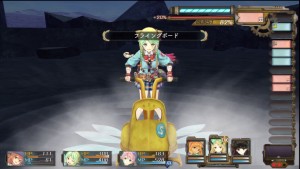
As for the battle system, the party members are now in a fixed position, although you have access to 6 party members. However, assists are now done differently. Active party members cannot do assist guard and attacks compared to previous games, only the ones in reserve.

Furthermore, the Burst Meter is now reintroduced and it fills by a certain amount after each attack and it decreases a little every time the enemy lands a hit. The amount it fills depends on how effective the attack is and how many enemies are affected by it. Once filled, burst mode will activate, which allows the party members’ attacks to become stronger. Burst mode also allows you to perform a special assist and variable strike (for additional damage) if you have all three members perform an assist attack when you use a skill or an attack item. Lastly, Shallistera can copy items while Shallotte can combine items during burst mode depending on which protagonist you chose to play as.
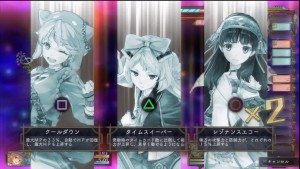
Later on in the game, when you fill the burst meter over 110%, you can apply a Field Burst, which gives beneficial effects for the party members on the field. It’s important to go over 150% on the burst meter because later optional bosses will have their own negative effects (in some cases, it shows up on the turn timeline as a red orb) that will make it difficult to defeat a boss. If that is the case, the only way to negate it is to apply three Field Bursts at the same time. Unlike Mana Khemia, the burst meter will carry over in most cases, except battles with certain conditions.

A new addition to the battle system is the Growth System. When your party members hit level 40, you will unlock it. From there, you can gain new abilities, increase stats, improve resistances or make it faster to recover when not on the field or decrease the assist gauge recovery time. When you level up, you will gain some points. However, you cannot unlock all of them, so you have to choose wisely.
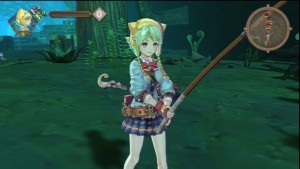
Lastly, there are some additions to the over world and ways to gather new items. Unlike previous games, you can now view the whole surrounding by moving the right control stick. I have to admit that it’s nice to be able to see and explore the whole environment. In addition, there are special ways to collect new items depending on the protagonist you choose to play. For instance, Shallistera can dowse for items while Shallotte can mine for items and fish.
Overall, while Atelier Shallie has a few changes (specifically the Life Task system) that gave some mixed feelings while having some game-breaking bugs, which eventually got patched, I have to admit that I like this game more than the first two games. To me, the time limit in the Twilight/Dusk series was becoming somewhat pointless since you end up having a lot of free time after finishing most of the main story, even if you messed up a bit. Still, getting all the endings is easy since there are only 5 in total (with the true ending being the same). Furthermore, it’s impossible to miss one of the events, even if you advance to the next chapter since you can see it later.
While I enjoyed the story for the fact that the dual protagonist narrative was handled better since there is a prologue that gives you a glimpse of both protagonists before you choose, there are some things that were left unresolved such as the Linca sisters and the mystery behind the world of Dusk/Twilight. Also, there is no mention of Ayesha until the credits, which is kind of sad considering that most, but all the main characters return in some shape or form in the last game. Flaws aside, I enjoyed Atelier Shallie quite a lot. If you don’t mind the new Life Task system, you will most likely like it.
The Bottom Line
Strengths: Improved Alchemy system, enjoyable battle system, changeable difficulty levels, ability to move the camera, new ways to gather items, addition of growth system and of course, no time limit. Also, the characters, music and the story were very enjoyable.
Weaknesses: Some things were left unresolved story wise. Also, there was some nasty game breaking bugs at launch, which has been fixed since then.


Leave a Reply